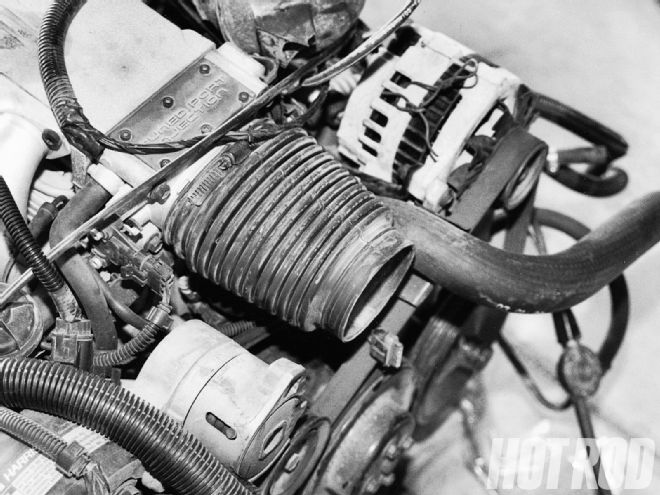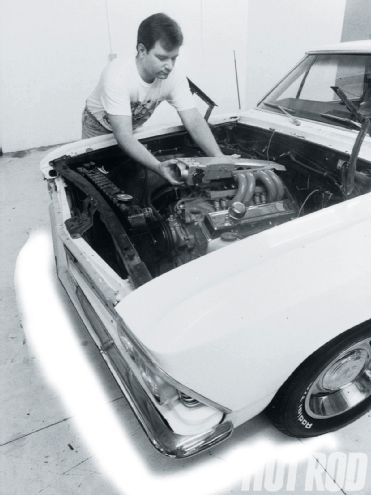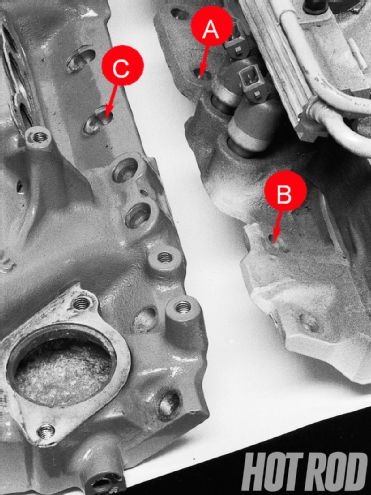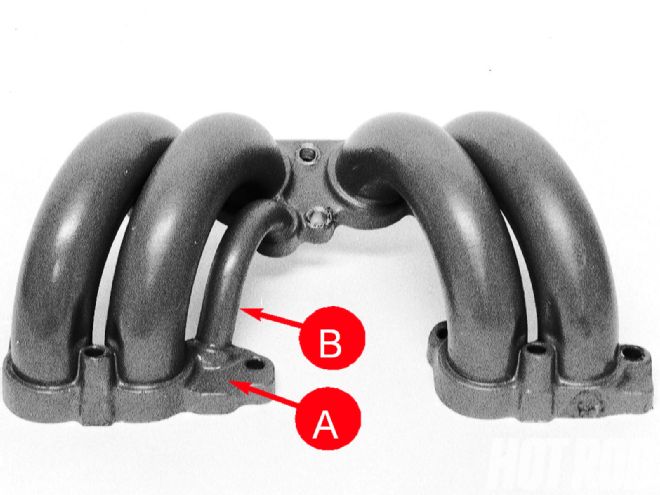
I remember sitting in auto shop listening to Mr. Curtis explain the virtues of fuel injection, circa early '80s. Even then, the term was far from new, and yet fuel injection was all but unobtainable on American V-8s. There were the mechanical systems of the late '50s and '60s, and Chevrolet was pitching its new Cross-Fire Injection (later known as Cease-Fire Injection). But if you wanted electronically controlled port fuel injection for your V-8, you were pretty much SOL.

Curtis was sold on the efficiency and accuracy that EFI promised and sang its praises in detail, going so far as to tell us how he wished he could get a "true" fuel-injection setup for his Corvette, a 1981 model with a computer-assisted Quadrajet. Sure enough, before I was even out of high school, Tuned Port Injection (TPI) was a reality-and it was like nothing we'd seen: wild runners, front-mounted air inlet, and individual fuel injectors. The Tuned Port Camaros and Corvettes were some of the fastest factory muscle machines the public had seen in quite a while. The down side was that most people were scared to death of the eight-legged monster straddling that most familiar V-8. How the heck do you tune it? What if it stops working? Where's the choke?
The years since the introduction of TPI in 1985 have proven the reliability of the system and have provided the opportunity for the general automotive public to get acquainted with it. Naturally, now that we know that TPI is as trick in function as it is to look at, we, like Mr. Curtis, want it for our classic muscle machines. Don't feel intim-idated; it's not as complicated as you may think. In fact, with the assistance of the aftermarket, it's pretty straightforward.
Things to Consider
The simplest way to merge TPI with your classic Chevy is to use the engine, harness, and computer from a donor car. Then it's a matter of bolting in the motor, routing the harness, and dealing with any conflicts that may arise with belt-driven accessories, exhaust plumbing, air-cleaner configurations, and so on, but the most labor-intensive work involves plumbing the fuel system.
This approach is certainly easier than merging TPI with your carbureted engine. But since most of us don't want to spend the money for another motor if the one we already have is good, combining the two is inevitable.
Your next decision is the source of the TPI componentry. You could piece a system together by scrounging the swap meets, but we advise against it. As you will see, the manifold assembly amounts to only one of the items you'll need to get up and running. Plus, there are many variations in TPI systems-year to year, F-car to Vette, 305 to 350, and so on. Thus, a "good deal" can quickly turn sour if you discover that a few of the more expensive items are missing or incompatible.
One alternative is a complete setup (manifolds, sensors, harness, fuel pump, and so on) from a salvage-yard single-donor car. Though you'd need to map out the particular adaptation, you'd still be headed in the right direction. Beyond that, investigate an aftermarket source specializing in retrofits, such as Street & Performance. These kits are intended for applications not originally equipped with TPI and usually feature a stand-alone wiring harness-this includes only the wiring needed for the EFI and its associated components, not all of the electrical items found in factory-equipped TPI engine bays. Regardless of your route, we'll discuss the various sensors and the differences in the systems, so you can select your plan of attack, and execute it without going broke.
Operation
Space doesn't permit a detailed discussion of how TPI works, but we did cover it in detail in the April '98 issue ("Injection Connection"). Here's what you need to know: Use an electric fuel pump capable of generating high levels of fuel pressure, and run a return line to recirculate fuel back to the tank. Install an oxygen sensor in the exhaust system, a vehicle-speed sensor (VSS) on the transmission, and a knock sensor in the block. Further, most of these items must be wired together and plugged into an electronic-control unit (ECU). Hah! You're getting nervous, aren't you. All of this stuff and its installation is explained in the accompanying photos and captions. And if that isn't enough, we've provided detailed sources to contact for more information.
 Due to component variations from 1985-92, it is important to use compatible pieces for a TPI conversion. The first potential obstacle is the angle of the center bolt holes in the intake manifold. On 1985-86 manifolds (not shown), these holes are at the same angle as all the rest, so they bolt to older engines without modification. On '87-'92 units (right), the center holes are drilled at a unique angle (A versus B). If you're using early heads that have traditional, uniform holes with a later manifold, file the manifold's center holes to fit. This method may sound questionable, but it is not a problem if done carefully. Another
alternative is an aftermarket manifold like the Edelbrock unit on the left, which has both bolt-hole angles (C).
Due to component variations from 1985-92, it is important to use compatible pieces for a TPI conversion. The first potential obstacle is the angle of the center bolt holes in the intake manifold. On 1985-86 manifolds (not shown), these holes are at the same angle as all the rest, so they bolt to older engines without modification. On '87-'92 units (right), the center holes are drilled at a unique angle (A versus B). If you're using early heads that have traditional, uniform holes with a later manifold, file the manifold's center holes to fit. This method may sound questionable, but it is not a problem if done carefully. Another
alternative is an aftermarket manifold like the Edelbrock unit on the left, which has both bolt-hole angles (C).
A Word About Camshafts
The "tuned" part of TPI refers to the length of the intake runners. The system was designed to take advantage of a phenomenon known as inertial supercharging, which we also discussed in the April '98 issue ("Air Raid: Breath from Above"). In short, the runner length takes advantage of the resonance wave that results when the intake valve closes. In order for this tuning to work, intake-valve timing must be synchronized with the runner length.
Most factory TPI cams run about 205 degrees of intake duration on a 116-degree lobe-separation angle. Of course, the speedball inclination is to increase duration and narrow the separation angle to get a rumpity-rump idle, but that can cause the TPI to run lousy. As a general guideline, intake duration shouldn't exceed 220 degrees at 0.050-inch lift, and the lobe separation shouldn't be less than 112 degrees. Any less separation and the reversion will dilute the intake-tuning effect and result in poor driveability.
Most performance-cam manufacturers offer hot TPI grinds, and some of them will even lend a little lope to the idle. But all cams offered with TPI in mind are for factory hydraulic-roller lifters, so if you're adapting the system to a flat-tappet engine, select a grind using the guidelines we've already listed. If you're thinking about a solid cam in a TPI engine, be forewarned: The knock sensor will likely detect the added valvetrain noise, mistake it for detonation, and order the ECM to retard ignition timing.
Other Enhancements
Air-cleaner elements are available for factory airboxes or in conical dimensions for custom fabrications. Throttle bodies with larger bores and butterflies, or with one large orifice and plate for extreme airflow, are also available. Larger intake runners are possible and can often be used with the stock manifold, which can be upgraded if necessary. In fact, while stock TPI is intended to build lots of low-end torque, there are aftermarket intakes with shorter, larger runners to support high-rpm operation. Such an intake system allows a wider range of cam profiling. And what good would a high-winding small-block be without killer cylinder heads? Most TPI swappers have success using traditional performance heads, but there are a number of castings (many of them aluminum) designed specifically for the EFI small-block.
 Passenger-side runners are the same for all TPI setups, but the driver's side varies. Pre-'89 pieces use an auxiliary injector, which would be located at "A" if so equipped (this one is not). Street & Performance offers a plug kit to "mate" early runners with later electronics. The small tube (B) feeds air to the ninth injector, although all driver's side runners have it.
Passenger-side runners are the same for all TPI setups, but the driver's side varies. Pre-'89 pieces use an auxiliary injector, which would be located at "A" if so equipped (this one is not). Street & Performance offers a plug kit to "mate" early runners with later electronics. The small tube (B) feeds air to the ninth injector, although all driver's side runners have it.
Before executing any major engine changes to your TPI-equipped Chevy, consult with a specialist to make sure you're on the right track. You can have the best of all worlds: performance, fuel economy, and sex appeal. How do you like that, Mr. Curtis?
TPI Swapping
Former Car Craft Editor John Baechtel's Chevy TPI Fuel Injection Swappers Guide and Mike Knell's Chevrolet TPI & TBI Engine Swapping manuals, as well as the Inside Your Tuned Port two-video set from Street & Performance, are excellent reference materials and well worth the minimal investment. We strongly recommend these sources. All go into far more detail than the space provided for this article allows.